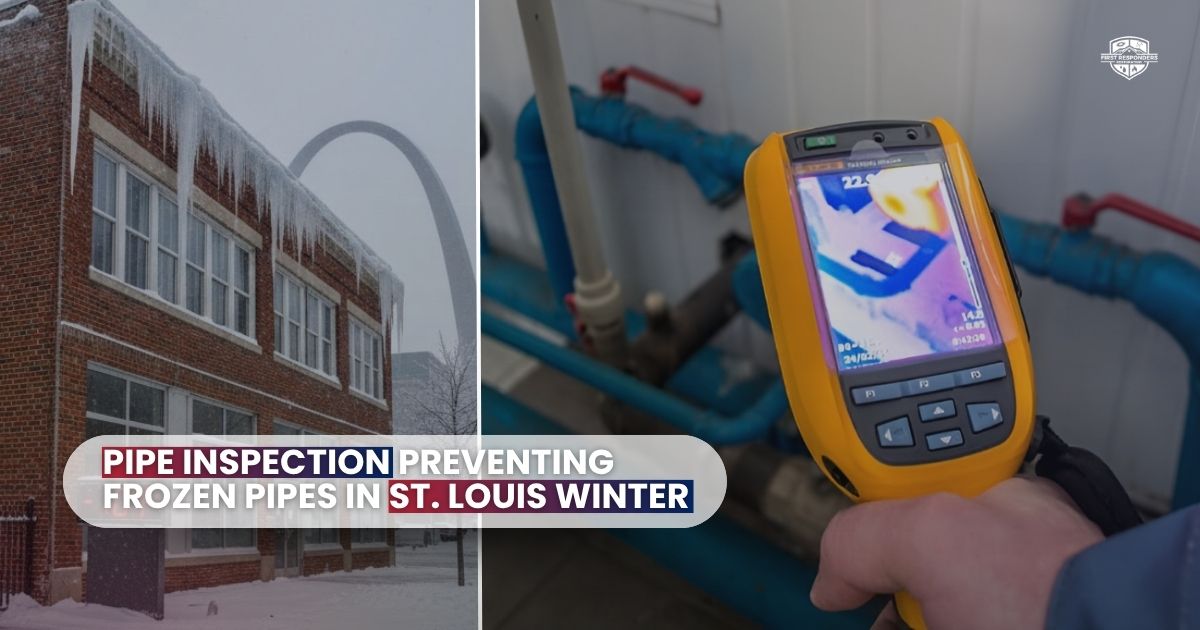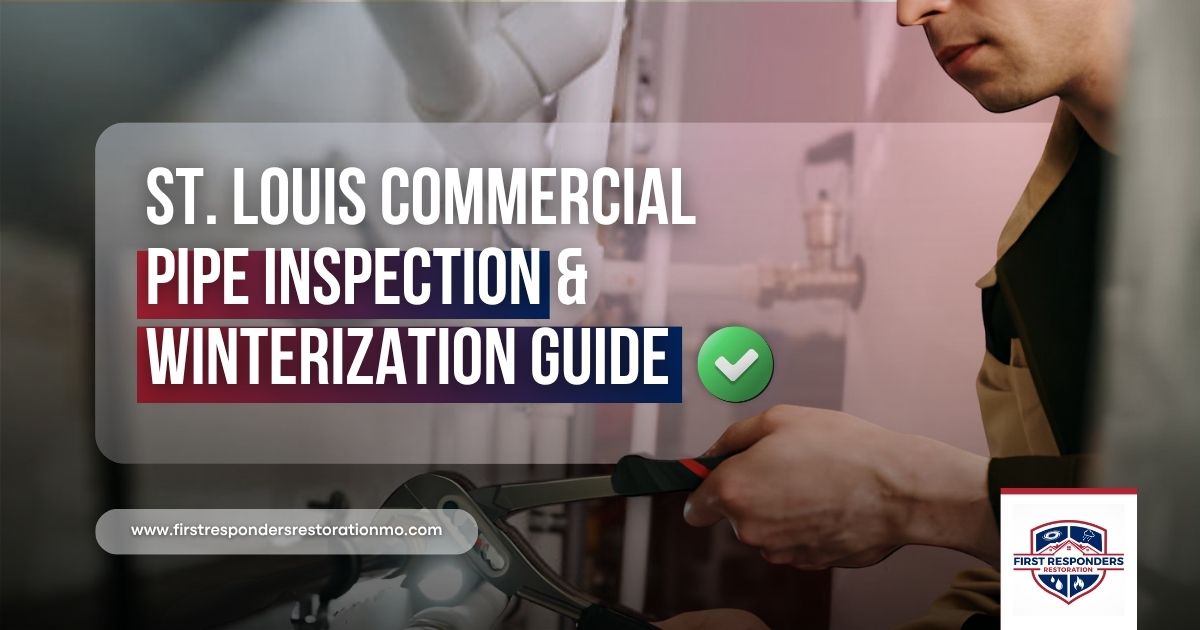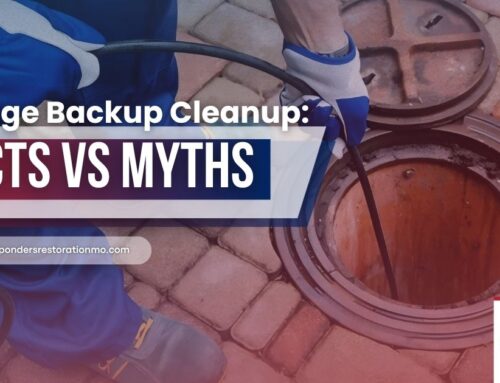St. Louis Commercial Pipe Inspection & Winterization Guide
When winter hits St. Louis, sudden temperature swings can put commercial buildings at serious risk. Commercial buildings, including warehouses and office complexes, face the same risk. Pipes that are cold or lack protection can freeze and burst, leading to expensive damage and halting business operations.
That’s why regular pipe inspection isn’t just another maintenance task; it’s an important financial safeguard. Finding leaks, weak spots, or insulation issues early can prevent a minor repair from turning into a major disaster.
Why Pipe Inspection Matters
St. Louis has a mix of humid and continental weather, so its winters are hard to predict. Temperatures can swing from mild afternoons to freezing nights below 22°F (-5°C). These rapid freeze-thaw cycles put extra stress on plumbing systems.
How Temperature Fluctuations Damage Pipes
Regular pipe inspection helps identify these vulnerable areas. Especially in exterior walls, attics, crawl spaces, and unheated zones before the cold weather sets in.
Common Causes of Frozen Pipes in Commercial Properties

Quick tip: Keep an eye on the most susceptible areas, like exterior-facing walls and unheated rooms. Regular checks are the best way to prevent major winter disasters.
Financial and Business Impact of Burst Pipes
Direct Water Damage Costs
A single burst pipe can release hundreds of gallons of water per minute, leading to thousands of dollars in repairs. The average commercial water damage claim exceeds $10,000, and this figure excludes the costs of structural work. In severe cases, costs can escalate dramatically:
A single plumbing failure in one high-rise building caused $4 million in documented damage. The water flooded multiple units, common areas, and vital electrical systems.
Beyond water cleanup, commercial properties face expenses for structural repairs to walls, ceilings, and floors. Left unaddressed, moisture can also lead to mold growth, which requires extensive and costly cleanup.
Business Interruption and Revenue Loss
The service downtime that follows a major water event can be financially crippling.
Lost revenue: Flooded areas often require temporary business closures, drying, and renovation, directly translating into lost income from halted operations.
Increased costs: In addition to lost sales, businesses must pay for temporary relocation, payroll, and other overhead. These unplanned expenses hit hard during the cleanup and restoration process.
Older infrastructure costs: Aging plumbing is prone to failure. Fixing it often requires full replacement and updates to meet modern building codes. This drives up costs, turning a simple repair into an expensive project.
Business impacts
Safety and Compliance Risks
The safety of employees and tenants is paramount, and burst pipes can introduce several risks.
Bad Reputation
A major pipe burst can hurt a company’s reputation. Customers may lose trust, and production delays can strain supplier relationships.
An aging water main break in North St. Louis caused citywide disruptions, affecting both residents and businesses. Such failures can lead to widespread flooding and service disruptions, forcing businesses to close and navigate complex repairs.
Pre-Winter Property Preparation Checklist
Proper preparation is your first line of defense. Use this checklist to safeguard your properties before temperatures drop. Our comprehensive, commercial-focused service addresses every crucial detail of pre-winter preparation. We handle the technical work, so you can focus on your business.
Inspect and Insulate Vulnerable Pipes
Our technicians conduct a full inspection to identify the pipes most at risk in your St. Louis properties. This goes beyond the obvious, including pipes in crawl spaces, attics, and exterior walls.
Professional insulation: We use professional-grade foam sleeves, fiberglass wraps, or UL-rated heat tape to protect vulnerable plumbing.
Temperature Control: In areas prone to freezing, we can install UL-rated heat tracing cables for an extra layer of protection.
Seal Gaps and Improve Building Envelope Efficiency
St. Louis’s historic buildings can have unique weak spots. Our experts find and seal the gaps that let in cold air and put your plumbing at risk.
Air leak detection: We use specialized tools to pinpoint air leaks around entryways, vents, and utility openings.
Professional Sealing: Our team applies heavy-duty caulk and insulation foam to seal gaps. This stops drafts, keeps the temperature steady, and gives you better energy efficiency.
Service HVAC and Maintain Indoor Temperatures
Consistent heat is your number one defense against frozen pipes. Our technicians ensure your HVAC system is operating at peak performance.
Comprehensive maintenance: We service your commercial HVAC system to ensure it’s reliable for the entire winter season.
Targeted Heat: We make sure thermostats maintain a minimum of 55∘F everywhere in your facility, protecting all plumbing.
Winterize Outdoor Plumbing and Sprinkler Systems
We handle the complex systems to ensure they are properly secured for the cold weather.
Full winterization: We professionally disconnect hoses, drain irrigation lines, and shut off water to all outdoor spigots, ensuring no water remains in the lines.
Fire system safety: For wet-pipe fire suppression systems, we verify antifreeze concentration and ensure heat tracing cables are functioning correctly.
Review Insurance and Emergency Contact Plans
Our services also include critical planning elements to prepare for the unexpected.
Coverage review: We can provide guidance on reviewing your commercial insurance policy to ensure it includes coverage for frozen pipe damage.
Emergency readiness: We help you develop a clear and accessible emergency plan, and we keep your emergency contacts—including our 24/7 restoration service—on file for a rapid response.
This winter, don’t just hope for the best. Be prepared with a professional partner that understands the specific needs of St. Louis commercial properties.
Contact us today to schedule your pre-winter inspection and winterization service.
Maintaining Building Safety
Even with solid pre-winter preparations, extreme cold snaps demand active management to prevent a costly emergency. Here’s how to maintain your building’s safety when the temperature drops.
Maintaining Building Safety
Even with solid pre-winter preparations, extreme cold snaps demand active management to prevent a costly emergency. Here’s how to maintain your building’s safety when the temperature drops.
Ensure consistent internal temperatures
Don’t let your guard down during off-hours or in less-trafficked areas. Consistent heat is your best defense against freezing pipes.
Set thermostats no lower than 55°F (12.8°C): This is the minimum temperature required to protect most plumbing. Even in unoccupied spaces or wings of the building, ensure adequate heat circulation is maintained.
Plan for power outages: A sudden loss of heat during a cold snap can rapidly create new risks. If you don’t have a backup power source, consider having an emergency action plan for restoring temporary heat to critical areas.
Leverage technology to monitor for leaks
The first sign of a frozen pipe often comes from a monitoring system, not a visual inspection. Technology provides an early warning that can save you from a major flood.
Install smart sensors: Place temperature sensors and smart leak detectors in high-risk areas like mechanical rooms, basements, and along exposed pipe runs.
Receive real-time alerts: These tools can send immediate notifications to your maintenance team if a temperature drop or water leak is detected, allowing for a rapid response before significant damage occurs.
Manage Building Access Points
Just because it’s cold outside doesn’t mean your building is airtight. Daily checks are critical during extreme cold to stop drafts from compromising indoor temperatures.
Conduct daily inspections: During deep freezes, inspect windows, doors, and vents daily. Look for drafts or gaps that may have formed due to age or weather changes.
Block cold air infiltration: Sealing drafts is a simple yet effective way to prevent localized cold spots from forming around interior pipes.
Respond effectively to leaks
Despite your best efforts, leaks can happen. A fast, organized response is critical for minimizing damage.
Shut off the water: Make sure all staff know the location of the main water shut-off valve to stop the flow of water immediately.
Call your restoration partner: Immediately contact your commercial restoration partner. Having their number on hand is essential for a rapid response and minimizing business interruption.
Emergency Preparedness and Rapid Response

Know Your Emergency Shutoff Points
In the event of a burst pipe, every second counts. Ensure maintenance staff know where main water shutoff valves are located and how to operate them quickly in an emergency. This knowledge can save you from a catastrophic flood.
Partner with a Trusted Restoration Team
When a pipe bursts, you need more than a simple repair; you need a full-service restoration partner. That’s where we come in. First Responders Restoration is ready 24/7 to respond across the entire St. Louis area.
Our certified technicians will handle every aspect of the recovery process. From initial water extraction and drying to full property restoration. Our goal is to minimize your downtime and financial losses so you can focus on your business.
Fire Suppression Systems and Critical Equipment
Fire sprinkler lines are often overlooked during winterization. Ensure antifreeze levels are correct and systems are properly maintained. Never drain sprinklers without coordinating with fire officials and insurers.
Long-term prevention for lasting safety
Frozen pipe prevention isn’t a one-time effort; it’s a long-term strategy for protecting your investment. By partnering with us, you can ensure your properties remain safe and compliant year after year.
We conduct annual inspections to check your property’s winter readiness. Our team will upgrade insulation as needed to take care of any new risks. We also thoroughly document each season’s maintenance steps, providing a record that supports insurance claims and compliance requirements.
Partnering with First Responders Restoration ensures long-term safety and peace of mind. We make sure you meet local building standards and have a reliable expert ready to act immediately.
Protect Your Property This Winter
Winter in St. Louis doesn’t have to spell disaster. With proactive pipe inspection, thermal monitoring, and professional maintenance, commercial properties can avoid costly damage, maintain compliance, and keep operations running smoothly.
Partnering with experts like First Responders Restoration ensures your property stays safe, dry, and prepared no matter how cold it gets.






Leave A Comment